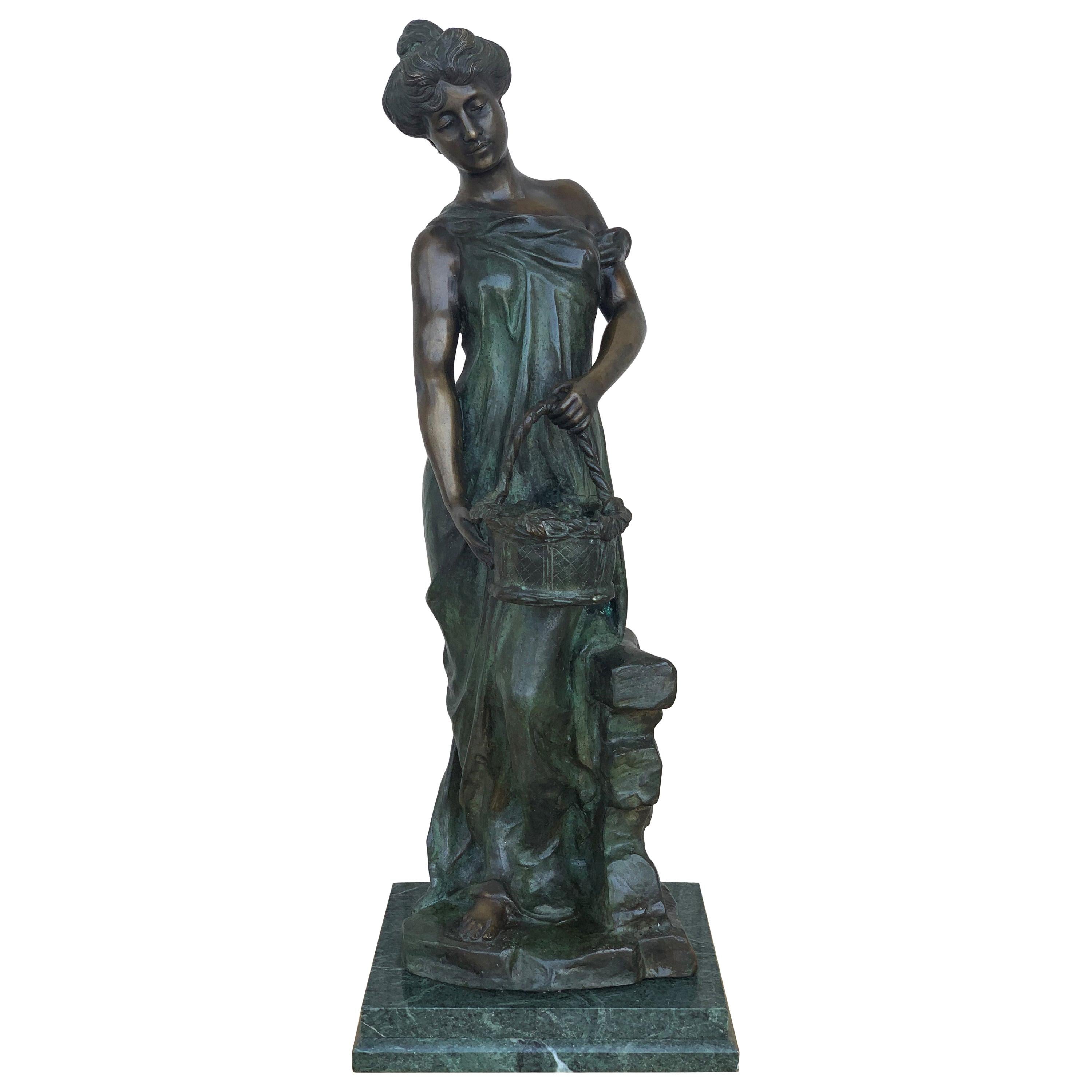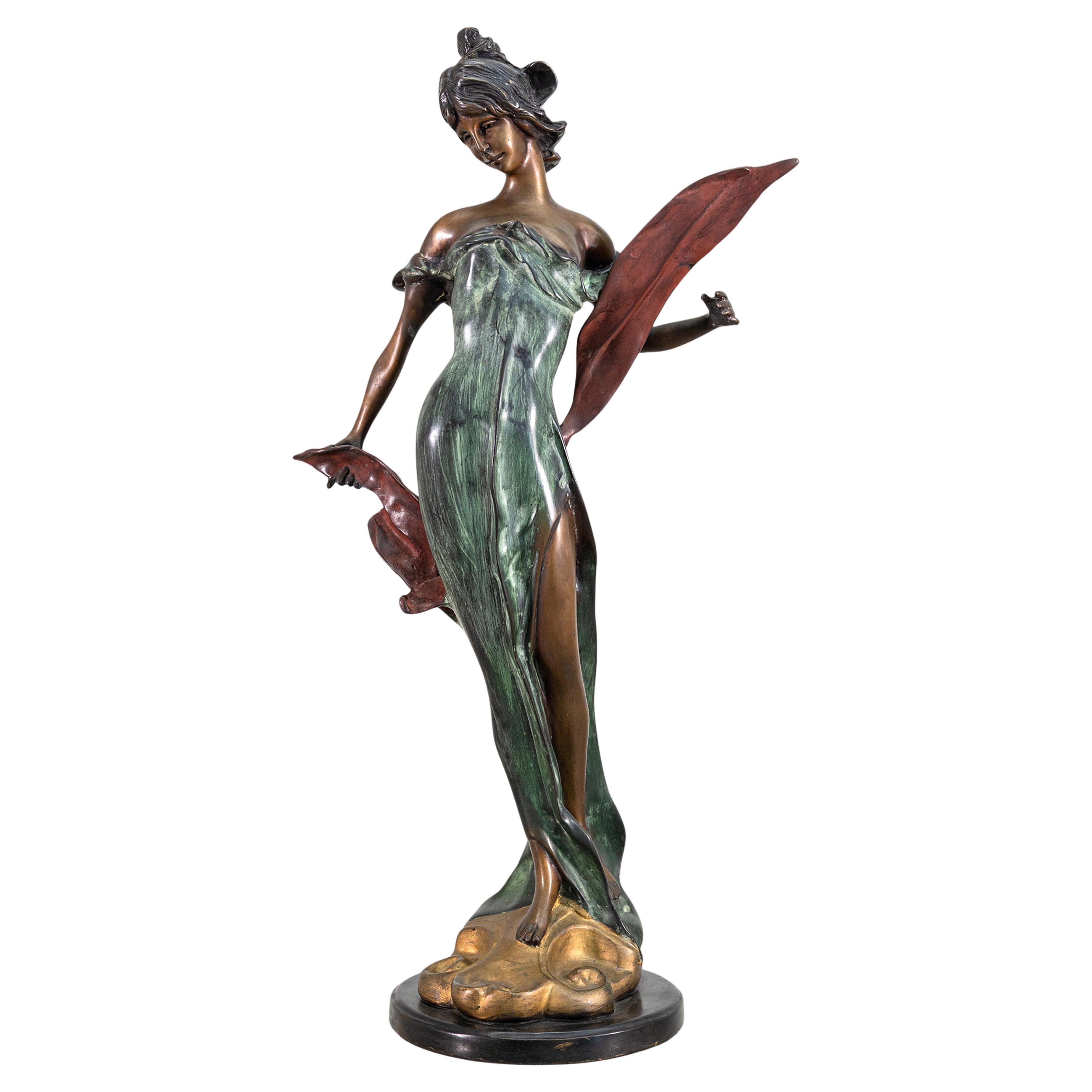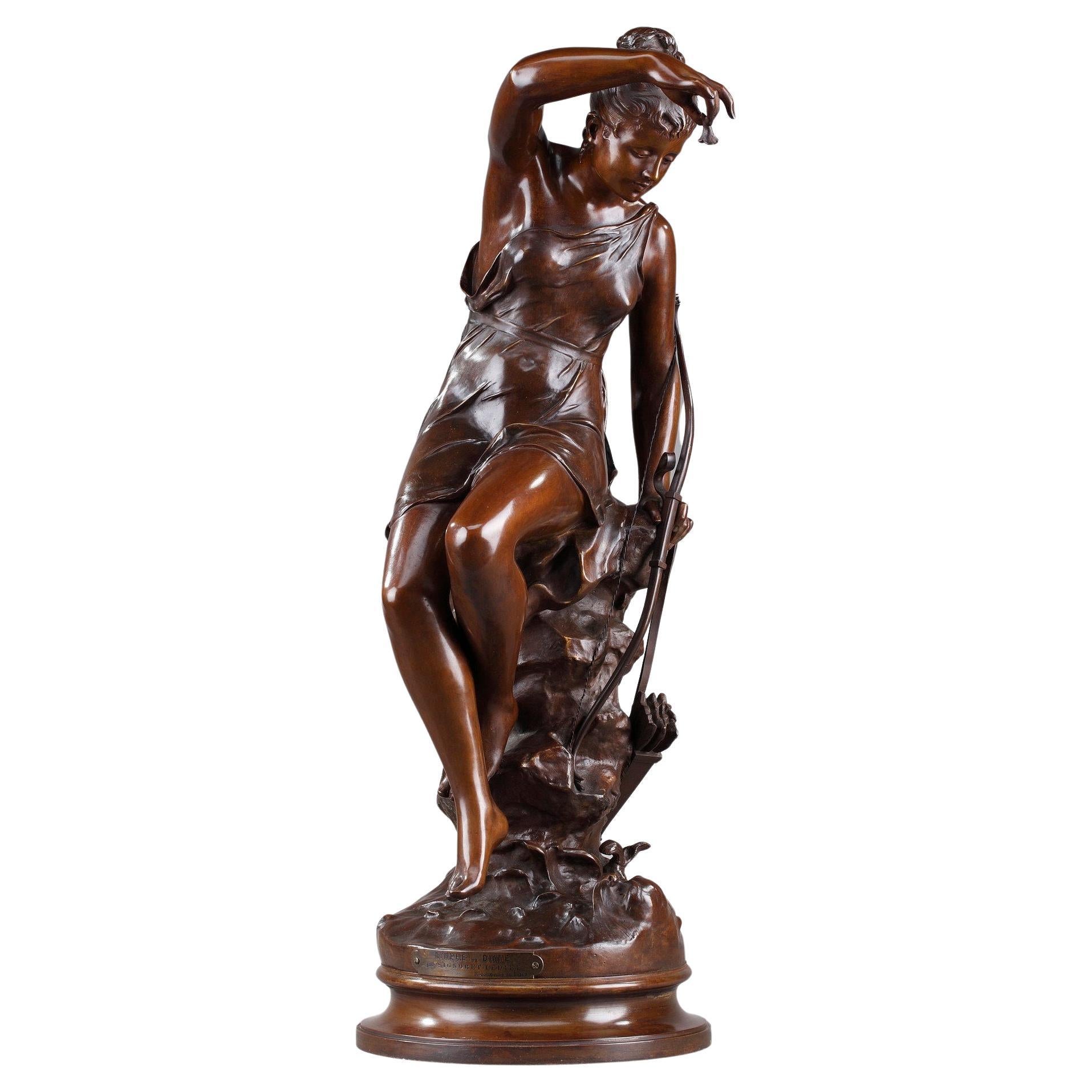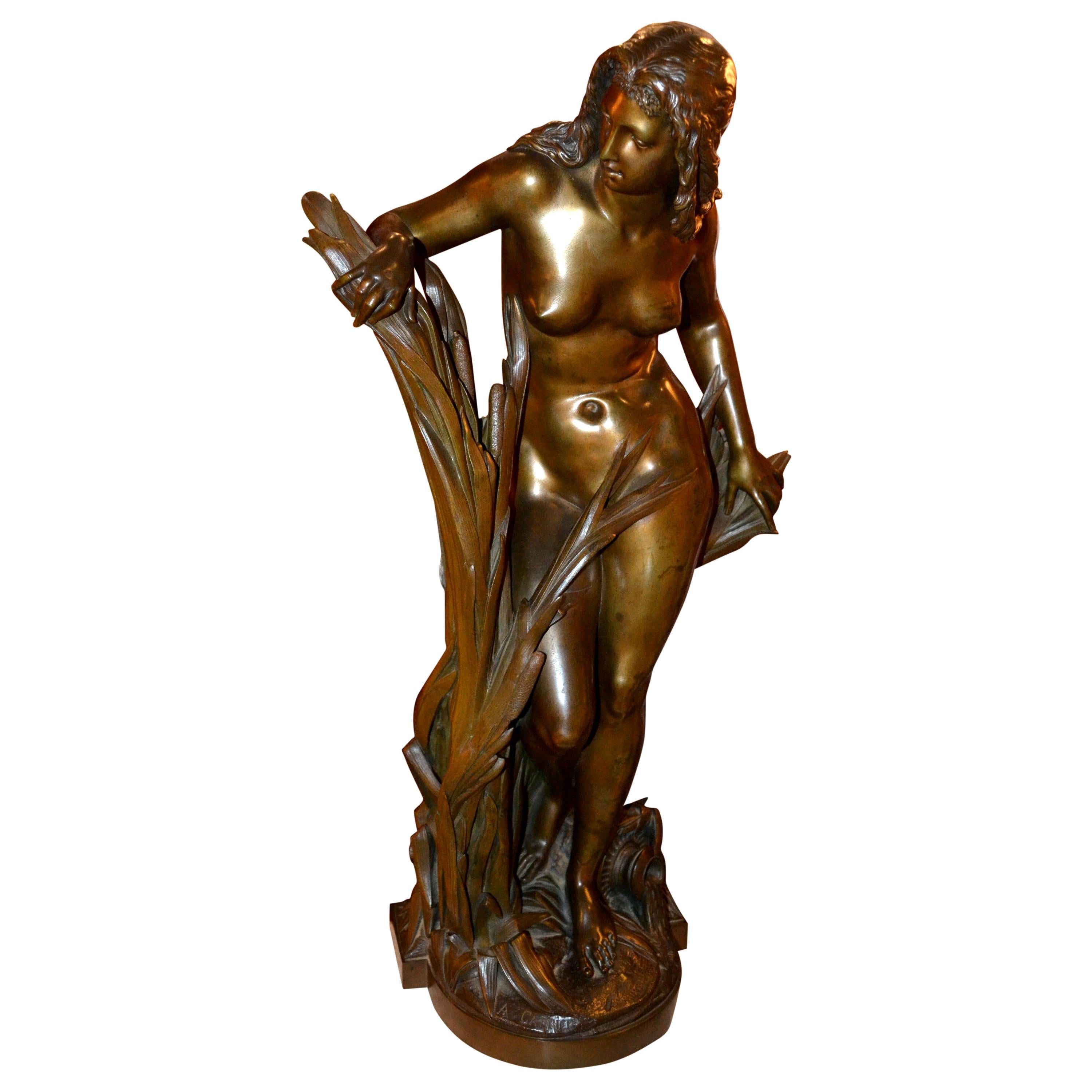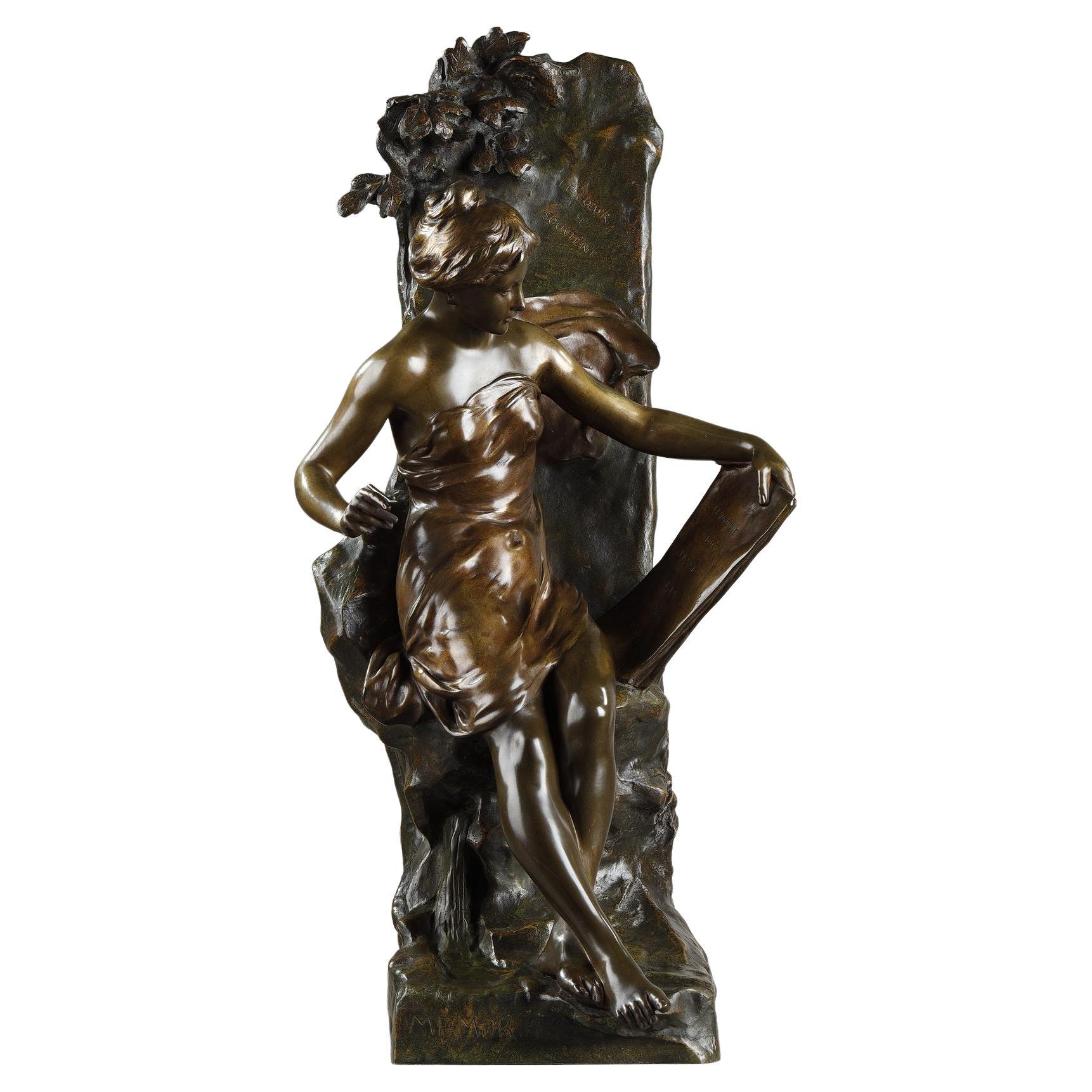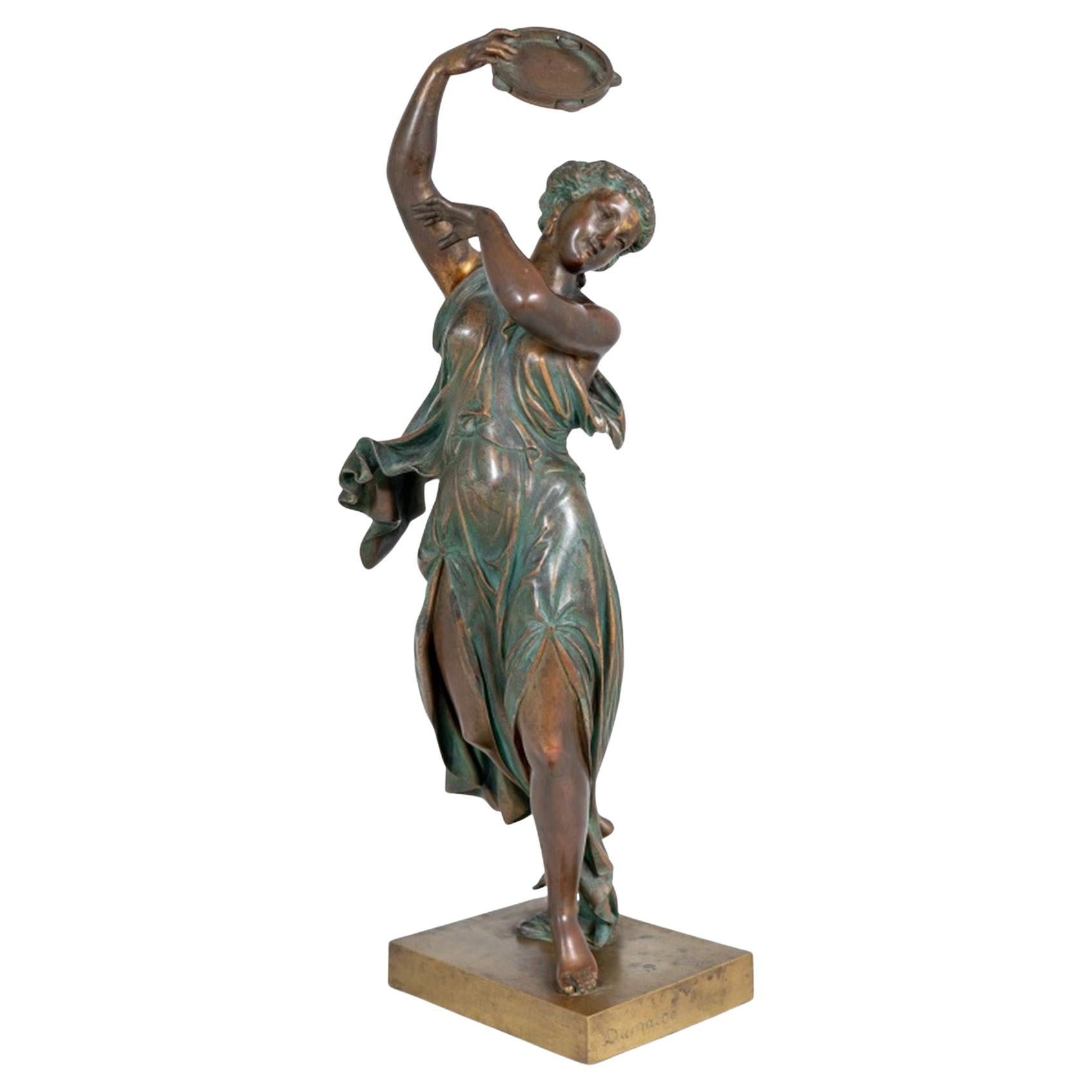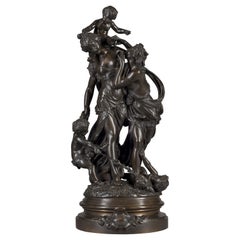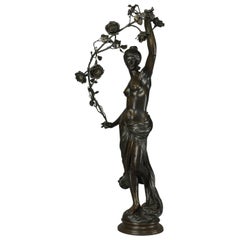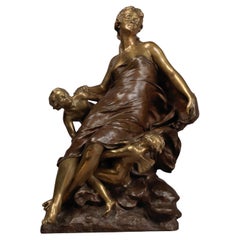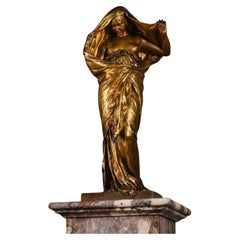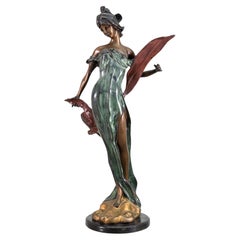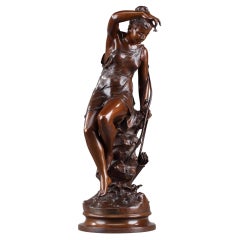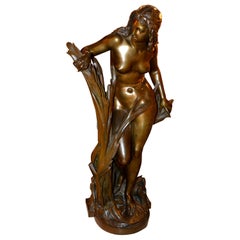Items Similar to A Fine And Large Patinated Bronze Figure Of A Sea Nymph
Video Loading
Want more images or videos?
Request additional images or videos from the seller
1 of 12
A Fine And Large Patinated Bronze Figure Of A Sea Nymph
$49,395.40
£36,000
€42,130.33
CA$68,905.50
A$74,746.90
CHF 39,306.10
MX$909,518.71
NOK 491,389.53
SEK 463,440.67
DKK 314,556.85
About the Item
Luca Madrassi (Italian, 1848–1916)
A Fine And Large Patinated Bronze Figure Of A Sea Nymph, Entitled ‘La Fée Des Mers’ (The Spirit Of The Seas)
The semi clad winged nymph, holding aloft billowing drapery in one hand and a flower in the other, with a scallop shell diadem, standing on a shell cast base, on a veined cream marble socle plinth base.
Signed 'MADRASSI' on the seashell.
Italy, Circa 1900.
Titled ‘La Fée Des Mers’ (The Spirit Of The Seas), the subject is indebted to the Nereides of Greek mythology, who symbolized everything that is beautiful and kind about the sea, and the Oceanids who were born to their father Oceanus, the great primordial world-encircling river, and their mother Tethys, a sea goddess. Famous amongst them are Calypso, who enchanted Odysseus, and Clytie, who loved the god of the sun Helios in vain and for her pains was turned into a violet flower that gazes at the Sun in its diurnal journey.
Born in Tricesimo, Italy in 1848, Madrassi began his art studies in Rome before studying at the Ecole des Beaux-Arts in Paris, under the famous master Pierre-Jules Cavelier.
Madrassi joined the studio of the famous sculptor Albert-Ernest Carrier-Belleuse's (1824-1887) and later Antoine Bourdelle (1861-1929); both of which had great influence on the playful romantic quality of his work. He also assisted the Scottish sculptor Lord Ronald Gower (1845-1916). Known primarily for busts and statuettes his work is typically defined by an imaginative and sensitive interpretation of allegorical themes.
Madrassi exhibited frequently at the Salon of the Société des Artistes Francais from 1879 onwards, obtaining an honourable mention on several occasions (1881 , 1882 , 1883 and 1885) and a third-class medal in 1896. In 1890 he finally obtained French nationality and became a full member of the Société des Artistes Français. He also exhibited at the Salon of the Société Nationale des Beaux-Arts in 1896.
- Creator:Luca Madrassi (Sculptor)
- Dimensions:Height: 50.4 in (128 cm)Width: 17.33 in (44 cm)Depth: 17.33 in (44 cm)
- Materials and Techniques:Bronze,Patinated
- Place of Origin:
- Period:
- Date of Manufacture:Circa 1900
- Condition:Wear consistent with age and use.
- Seller Location:Brighton, GB
- Reference Number:Seller: B779911stDibs: LU1028040523462
About the Seller
5.0
Recognized Seller
These prestigious sellers are industry leaders and represent the highest echelon for item quality and design.
Established in 1964
1stDibs seller since 2014
58 sales on 1stDibs
Typical response time: <1 hour
Associations
The British Antique Dealers' AssociationLAPADA - The Association of Arts & Antiques Dealers
- ShippingRetrieving quote...Shipping from: Brighton, United Kingdom
- Return Policy
Authenticity Guarantee
In the unlikely event there’s an issue with an item’s authenticity, contact us within 1 year for a full refund. DetailsMoney-Back Guarantee
If your item is not as described, is damaged in transit, or does not arrive, contact us within 7 days for a full refund. Details24-Hour Cancellation
You have a 24-hour grace period in which to reconsider your purchase, with no questions asked.Vetted Professional Sellers
Our world-class sellers must adhere to strict standards for service and quality, maintaining the integrity of our listings.Price-Match Guarantee
If you find that a seller listed the same item for a lower price elsewhere, we’ll match it.Trusted Global Delivery
Our best-in-class carrier network provides specialized shipping options worldwide, including custom delivery.More From This Seller
View All'Bacchantes', a Fine Patinated Bronze Figural Group After Clodion, circa 1870
By Claude Michel Clodion
Located in Brighton, West Sussex
'Bacchantes', a fine patinated bronze figural group after Claude Michael Clodion, French (1738-1814).
French, circa 1870.
Signed 'Clodion' to the base and inscribed 'BACCHANTE...
Category
Antique Late 19th Century French Figurative Sculptures
Materials
Bronze
'Grand Nu Aux Feuillages', a Fine Patinated Bronzed Figural Group, circa 1900
By Alois Mayer
Located in Brighton, West Sussex
'Grand Nu Aux Feuillages', a fine patinated bronzed figural group by Alois Mayer.
German, circa 1900.
Signed 'A. Mayer'.
Alois Mayer (1855-1936) Was a German Sculptor who...
Category
Antique Late 19th Century German Figurative Sculptures
Materials
Bronze, Iron
'Cupid & Psyche' an Important Bronze Figure by François-Raoul Larche
By François-Raoul Larche
Located in Brighton, West Sussex
'Cupid & Psyche' - An important parcel-gilt and patinated bronze figure, by François-Raoul Larche.
Signed to the base 'Raoul Larche 1891'.
This finely cast parcel-gilt bronze figure depicts Cupid and Psyche with Zephyr.
François-Raoul Larche (1860-1912), the son of an ornamental sculptor, was a well-known Art Nouveau sculptor...
Category
Antique 19th Century French Figurative Sculptures
Materials
Bronze
Bronze Figure of 'La Nature Se Dévoilant Devant La Science'
By Louis Ernest Barrias
Located in Brighton, West Sussex
Bronze figure of 'La Nature se dévoilant devant la Science' by Louis-Ernest Barrias.
Inscribed 'E. Barrias' and with Susse Frères foundry cachet and further Susse inscription.
Thi...
Category
Early 20th Century French Figurative Sculptures
Materials
Bronze
'Bonne Année, Bonne Santé', a Bronze Figure by Adolphe Maubach, circa 1900
By Adolph Maubach
Located in Brighton, West Sussex
'Bonne Année, Bonne Santé' -A fine patinated bronze figure by Adolphe Maubach.
French, circa 1900.
Signed 'Adolphe Maurbach' and bearing a gilt-bronze title plaque 'Bonne Anné...
Category
Antique Late 19th Century French Figurative Sculptures
Materials
Bronze
A Patinated Bronze Figure Of 'Peter Pan', By Sir George James Frampton
Located in Brighton, West Sussex
Sir George James Frampton (British, 1860-1928)
A Patinated Bronze Statue Of Peter Pan
Depicted playing the pipes and conducting with his right hand. Standing on a naturalistically cast base.
Signed 'G F' in a monogram and 'P P' in a roundel. Dated 1913.
England, Dated 1913.
Provenance:
Gerald Rufus Isaacs, 2nd Marquess of Reading (1889 –1960) and Eva Violet Mond Isaacs, Second Marchioness of Reading (1895–1973).
Thence by descent until sold in 1996.
The present charming statuette of Peter Pan, dated 1913, is an exceptionally fine and early reduction of the life-size bronze exhibited by Frampton at the Royal Academy in 1911. Barrie unveiled the statue in Kensington Gardens on 30 April 1912, without fanfare and without permission, so that it might appear to children that the fairies had put it in place overnight. He published a notice in The Times newspaper the following day, 1 May: "There is a surprise in store for the children who go to Kensington Gardens to feed the ducks in the Serpentine this morning. Down by the little bay on the south-western side of the tail of the Serpentine they will find a May-day gift by Mr J.M. Barrie, a figure of Peter Pan blowing his pipe on the stump of a tree, with fairies and mice and squirrels all around. It is the work of Sir George Frampton...
Category
Vintage 1910s English Figurative Sculptures
Materials
Bronze
You May Also Like
20th Century Cast Bronze Statue of a Nymph Signed by Ferdinando de Luca, Italy
By Ferdinando de Luca
Located in Miami, FL
The famed Italian sculptor Ferdinando de Luca created this incredible cast bronze likeness of a girl in the 20th century. Its stylized Art Nouveau aesthetic has a vibrancy which perf...
Category
Early 20th Century European Art Nouveau Figurative Sculptures
Materials
Marble, Bronze
$3,760 Sale Price
20% Off
Eduardo Rossi Sea Nymph Galatea Signed Art Nouveau Bronze Figurative Sculpture
Located in Keego Harbor, MI
A figurative Art Nouveau "Sea Nymph Galatea" bronze table sculpture by Italian artist Eduardo Rossi (1867-1926). Etched signature on base. An elegant composition with curved lines an...
Category
Early 20th Century Italian Art Nouveau Figurative Sculptures
Materials
Bronze
Bronze Sculpture, "Diana's Nymph" After Lucie Signoret-Ledieu
Located in Paris, FR
Beautiful statue in patinated bronze representing Diana, godess of the hunt, also called Nymph of Diana, after the work of Lucie Signoret-Ledieu. It represents the goddess seated on ...
Category
Antique 1890s French Figurative Sculptures
Materials
Bronze
19th Century Bronze Statue of a Nymph by A. Carrier
By Albert-Ernest Carrier-Belleuse
Located in Vancouver, British Columbia
A very fine cast and chased bronze showing a beautiful standing nude nymph, parting and emerging from between tall bull rushes at the edge of a stream. At her feet is a water jug. Th...
Category
Antique Late 19th Century French Napoleon III Figurative Sculptures
Materials
Bronze
$6,160 Sale Price
30% Off
Sculpture "Memoria" in Patinated Bronze, Signed Emile Louis Picault
By Émile Louis Picault
Located in Paris, FR
Figure "Memoria" in bronze with brown and green shaded patina signed Emile Louis Picault. It represents a young woman seated, dressed in a drapery,...
Category
Antique 1890s French Figurative Sculptures
Materials
Bronze
E. H. Dumaige Patinated Bronze Figure of a Muse
By Etienne-Henri Dumaige
Located in Astoria, NY
Etienne-Henri Dumaige (French, 1830-1888) Patinated Bronze Sculpture of a Dancing Muse, late 19th century, the draped dancing figure upholding a tambourine on a rectangular plinth, s...
Category
Antique Late 19th Century Neoclassical Figurative Sculptures
Materials
Bronze
More Ways To Browse
Lucas Gold
Antoine Bourdelle
Madrassi Bronzes
19th Century Italian Porcelain Figurines
A Santini
Alloy Sculpture
Angel Kneeling
Antique Costa Rica
Antique German Bisque
Antique Gold Pan
Art Deco Goddess
Art Deco Resin Sculpture
Black Egypt Sculpture
Bronze French Soldier
Bronze Sculpture Bacchus
Clesinger Bronze
Cornucopia Sculpture
Cracked Egg
